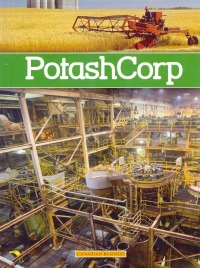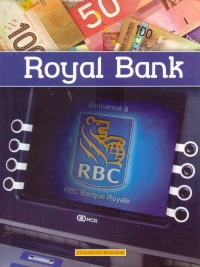| ________________
CM . . .
. Volume XX Number 26. . . .March 7, 2014 
 |
PotashCorp. (Canadian Business).
Kaite Goldsworthy.
Calgary, AB: Weigl Educational Publishers (Distributed by Saunders Book Company), 2014.
48 pp., pbk. & hc., $14.95 (pbk.), $27.95 (hc.).
ISBN 978-1-77071-532-5 (pbk.), ISBN 978-1-77071-531-8 (hc.).
Subject Heading:
Potash Corporation of Saskatchewan-History-Juvenile literature.
Grades 4-7 / Ages 9-12.
Review by Val Ken Lem.
*** /4
|
| |
|
 |
Royal Bank. (Canadian Business).
Simon Rose.
Calgary, AB: Weigl Educational Publishers (Distributed by Saunders Book Company), 2014.
48 pp., pbk. & hc., $14.95 (pbk.), $27.95 (hc.).
ISBN 978-1-77071-536-3 (pbk.), ISBN 978-1-77071-535-6 (hc.).
Subject Heading:
Royal Bank of Canada-History-Juvenile literature.
Grades 4-7 / Ages 9-12.
Review by Val Ken Lem.
*** /4
|
| |
|

excerpt:
Saskatchewan is a province with strong agricultural roots. It is also home to the world’s largest fertilizer company in terms of capacity. Potash Corporation of Saskatchewan, Inc., or PotashCorp, produces potash, phosphate, and nitrogen—the three main nutrients used worldwide for increasing crop yields. PotashCorp fertilizer is used in agriculture and animal nutrition, as well as in general industry. Twenty percent of the potash used around the world today is produced by PotashCorp. The company is based in the city of Saskatoon, Saskatchewan, but has operations in seven countries around the world. (From PotashCorp.)
The branch manager supervises all employees at a specific bank. Branch managers promote and market the branch and its products and must meet sales targets set by the bank’s head office. The job also involves ongoing coaching and development of the branch staff, so that a high level of customer service is maintained. Branch managers often meet with customers to resolve any complaints or problems that arise at the branch. (From Royal Bank.)
These two contributions to the “Canadian Business” series continue to follow the same successful template: brief histories of the firms, their growth, international growth, maps showing distribution of the firms’ reach internationally, the companies’ brands, brief profiles of executives and front line staff, company FAQs, customer/client experience, giving back/philanthropic activities, competitors, charts illustrating success, innovation and technology, facing challenges, the future, timelines, top 10 facts, an activity, quiz, glossary and index.
The books are attractively designed with colourful photographs, maps and graphic illustration of data. Most of the photographs used are quite generic yet appropriate. Sometimes it would be informative to have a descriptive caption. The enormous mining machine used as a central point on the page “PotashCorp Top 10” is puzzling at first as it is not clear what is being shown and whether it is supposed to illustrate the specific facts that point down to it. The stock photo of the façade of The Toronto Stock Exchange that appears in both books is the historic exchange that was sold in 1983 and has served as the home to a design museum for two decades. The indexes could be more complete. In PotashCorp, there should be an entry for Trinidad (or more correctly Trinidad and Tobago) since the book talks about a model farm in Trinidad and the presence of a nitrogen operation in the Caribbean country.
The Potash Corporation of Saskatchewan was created as a crown corporation in 1975 at a time of turmoil in the industry in the province. Within a few years, the firm was producing 40 percent of the potash in the province and looking for new markets in the U.S. Following a change of government, the province decided to privatize the corporation in 1989. Since then, PotashCorp has continued to grow, becoming more diversified as it acquired phosphate and nitrogen operations to supplement its core business in potash. The importance of fertilizers in industrialized agriculture cannot be underestimated. Some of the resources are used as animal feed, in metal finishing, industrial uses and even purified for use in food (phosphoric acid is an ingredient of cola drinks). As a mining industry, it is not surprising that the frontline employee groups noted are geologists, mine engineering technologists and process engineers. With 2012 sales almost reaching eight billion dollars and net income topping two billion, PotashCorp was the clear income leader when compared to its national and international competitors that year. The hostile takeover bid by Australian mining company BHP Billiton in the fall of 2010 was withdrawn after the federal government of Canada declared the takeover was not in the best interests of Canada. Challenges continued to swirl around the firm, as buyers in China and India balked in 2012 at signing contracts anywhere near the prices that they had previously paid. Anti-trust allegations made in the United States in 2008 against PotashCorp and several of its competitors were settled out of court in January 2013. The firm is currently expanding its capacity at mines in New Brunswick and Saskatchewan so that by 2015 it will have more than doubled its annual capacity of potash to 17.1 million tonnes.
Goldsworthy strives to take an impartial view on the political and legal issues that impact on the history and future of PotashCorp. She notes that, at the time of its creation in 1975, the private companies mining potash in Saskatchewan objected to new provincial taxes, and some even challenged the constitutionality of the taxes in the courts. The outcome of this struggle is never explained. The nuanced politics at the time of the BHP takeover bid are not explored. The companies accused of anti-trust activities by cutting production in an effort to boost prices are let off quite easily in the summation:
Even though the companies denied breaking the laws, PotashCorp felt it was better to focus its energy and resources on business rather than continuing to fight the lawsuit.
Two questions that should be raised in the case of all businesses engaged in extractive industries are: How robust are the known deposits of the resource under the control of the firm, and how long is the resource expected to last given the current or proposed rate of extraction? This also raises questions about food security given the agricultural industry’s reliance upon fertilizers.
The Royal Bank of Canada operates under the master brand name RBC. It is Canada’s largest financial services provider, but it had a modest start as the Merchants’ Bank in Halifax in 1864. After Confederation, it obtained a federal charter and expanded into other provinces and abroad. In the first decade of the last century, the bank changed its name to the Royal Bank of Canada and moved its headquarters to Montreal, then the financial capital of Canada. Today, the bank operates some 1200 branches across Canada serving ten million customers, and it has a total of fifteen million customers in 50 countries. International growth has not always been easy as noted in the section on challenges wherein its efforts to make greater inroads into branch banking in the USA in the early 2000s failed. The firm has a remarkable brand, a striking logo and has developed some memorable marketing campaigns, including the current one featuring Arbie, the bowler-hat wearing character that first appeared in 2008. Sponsorships and especially title sponsorship of sporting events have helped to promote the brand. The bank is also a leader in technical innovation. The rebranding in 2001 to RBC Financial Group emphasizes the international reach of the bank and its full-service financial services that extend beyond traditional personal and commercial banking to insurance, investment counseling for institutional clients, wealth management for wealthy individuals, and investment banking in the global capital markets.
Rose notes that the bank remained stable during the recession of 2008, but he fails to grasp the opportunity to acknowledge the role of federal regulations in helping the Canadian banks avoid the crises that some other banks faced in Europe and the USA. He avoids other controversial situations, such as the role of unpopular client charges in boosting the bank’s profits, and the background noise of the separatist Parti Québécois victory in Quebec that coincided with the move of the corporate headquarters to Toronto in 1976. In such a brief work, it is perhaps unfair to expect the author to deal with all of these matters.
One complaint that applies to the series is the amount of space devoted to the roles of senior executives compared with the brief descriptions of frontline worker positions. Young readers interested in learning about possible careers are more likely to become a frontline worker than a senior manager or executive. It is unfortunate, too, that compensation levels are not provided for various positions and indications of the amount of full-time versus part-time employment provided by the firms.
Overall, both PotashCorp and Royal Bank are informative introductions to two very different businesses, one that is largely unknown to most readers and one that is well-known across the country because of its widespread local branch operations and national advertising campaigns. Both employ thousands of Canadians, pay taxes and other charges to governments, engage in corporate philanthropy and reward their shareholders with dividends in concert with their success.
Recommended.
Val Ken Lem is a librarian at Ryerson University in Toronto, ON.

To comment
on this title or this review, send mail to cm@umanitoba.ca.
Copyright © the Manitoba Library Association. Reproduction for personal
use is permitted only if this copyright notice is maintained. Any
other reproduction is prohibited without permission.
NEXT REVIEW |
TABLE OF CONTENTS FOR THIS ISSUE
- March 7, 2014.
AUTHORS |
TITLES |
MEDIA REVIEWS |
PROFILES |
BACK ISSUES |
SEARCH |
CMARCHIVE |
HOME |

